Hawa Mahal
| Hawa Mahal | |
|---|---|
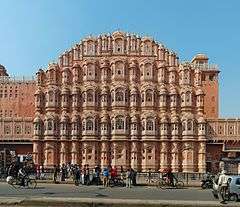 Front of the Hawa Mahal, Jaipur | |
 Location within Rajasthan | |
| General information | |
| Architectural style | Rajput Architecture |
| Country | India |
| Coordinates | 26°55′26″N 75°49′36″E / 26.9239°N 75.8267°ECoordinates: 26°55′26″N 75°49′36″E / 26.9239°N 75.8267°E |
| Construction started | N/A |
| Completed | 1799 |
| Demolished | N/A |
| Client | Maharaja Sawai Pratap Singh |
| Technical details | |
| Structural system | Red and pink sandstone |
| Design and construction | |
| Architect | Lal Chand Ustad |
Hawa Mahal (English translation: "Palace of Winds" or "Palace of the Breeze") is a palace in Jaipur, India. It is constructed of red and pink sandstone. The palace sits on the edge of the City Palace, Jaipur, and extends to the zenana, or women's chambers.
The structure was built in 1799 by Maharaja Sawai Pratap Singh. He was so inspired by the unique structure of Khetri Mahal that he built this grand and historical palace. It was designed by Lal Chand Ustad. Its unique five-story exterior is akin to the honeycomb of a beehive with its 953 small windows called jharokhas decorated with intricate latticework.[1] The original intent of the lattice design was to allow royal ladies to observe everyday life and festivals celebrated in the street below without being seen, since they had to obey the strict rules of "purdah", which forbade them from appearing in public without face coverings. This architectural feature also allowed cool air from the Venturi effect (doctor breeze) to pass through, thus making the whole area more pleasant during the high temperatures in summer.[1][2][3] Many people see the Hawa Mahal from the street view and think it is the front of the palace, but in reality it is the back of that structure.[4]
In 2006, renovation works on the Mahal were undertaken, after a gap of 50 years, to give a face lift to the monument at an estimated cost of Rs 4568 million.[5] The corporate sector lent a hand to preserve the historical monuments of Jaipur and the Unit Trust of India has adopted Hawa Mahal to maintain it.[6] The palace is an extended part of a huge complex. The stone-carved screens, small casements and arched roofs are some of the features of this popular tourist spot. The monument also has delicately modeled hanging cornices.
Architecture


The palace is a five-storey pyramidal shaped monument that rises 50 feet (15 m). The top three floors of the structure have the width of a single room, while the first and second floors have patios in front of them. The front elevation, as seen from the street, is like a honeycomb with small portholes. Each porthole has miniature windows and carved sandstone grills, finials and domes. It gives the appearance of a mass of semi-octagonal bays, giving the monument its unique façade. The inner face on the back side of the building consists of chambers built with pillars and corridors with minimal ornamentation, and reach up to the top floor. The interior of the mahal has been described as "having rooms of different coloured marbles, relieved by inlaid panels or gilding; while fountains adorn the centre of the courtyard".[7][8]
Lal Chand Ustad was the architect of this unique structure. Built in red and pink coloured sand stone, in keeping with the décor of the other monuments in the city, its colour is a full testimony to the epithet of "Pink City" given to Jaipur. Its façade depicting 953 niches with intricately carved jharokhas (some are made of wood) is a stark contrast to the plain looking rear side of the structure. Its cultural and architectural heritage is a true reflection of a fusion of Hindu Rajput architecture and Islamic Mughal architecture; the Rajput style is seen in the form of domed canopies, fluted pillars, lotus and floral patterns, and the Islamic style as evident in its stone inlay filigree work and arches (as distinguished from its similarity with the Panch Mahal at Fatehpur Sikri).[9]
The entry to the Hawa Mahal from the city palace side is through an imperial door. It opens into a large courtyard, which has double storeyed buildings on three sides, with the Hawa Mahal enclosing it on the east side. An archaeological museum is also housed in this courtyard.[10]
Hawa Mahal was also known as the chef-d'œuvre of Maharaja Jai Singh as it was his favourite resort because of the elegance and built-in interior of the Mahal. The cooling effect in the chambers, provided by the breeze passing through the small windows of the façade, was enhanced by the fountains provided at the centre of each of the chambers.[11]
The top two floors of the Hawa Mahal are accessed only through ramps. The Mahal is maintained by the archaeological Department of the Government of Rajasthan.[10]
Visitor information
The palace is located to the south of Jaipur city, at the main road intersection called the Badi Chaupad (big four square). Jaipur city is well connected by road, rail and air with the rest of the country.[9] The Sanganer International Airport is at a distance of 13 kilometres (8.1 mi) from the city.
Entry to the Hawa Mahal is not from the front but from a side road to the rear end.
It is particularly striking when viewed early in the morning, lit with the golden light of sunrise.[2][3]
Gallery
 Interior
Interior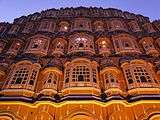 Hawa Mahal exteriors lit up at night.
Hawa Mahal exteriors lit up at night.- Coloured glass work. When the sun light enters, the entire chamber fills with the spectrum of various colours.
- View from the back part towards Samrat Yantra of Jantar Mantar in this photo at top right corner in the form of inclined wall. Isarlat is also visible in this photo at left top corner as a large tower.
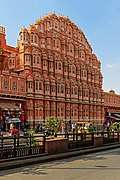 Hawa Mahal seen from the adjoining street
Hawa Mahal seen from the adjoining street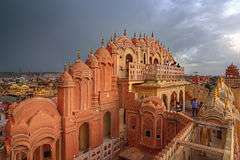 Top eastern side on a stormy afternoon
Top eastern side on a stormy afternoon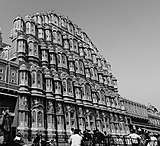 Hawa Mahal, Jaipur
Hawa Mahal, Jaipur- Rear view of the Hawa Mahal
References
- 1 2 Rai, Vinay; William L. Simon (2007). Think India: the rise of the world's next superpower and what it means for every American. Hawa Mahal. Dutton. p. 194. ISBN 0-525-95020-6. Retrieved 6 December 2009.
- 1 2 "Hawa Mahal". Retrieved 6 December 2009.
- 1 2 "Jaipur, the Pink City". Retrieved 6 December 2009.
- ↑ pareek, Amit kumar pareek and Agam kumar. "Hawa Mahal the crown of Jaipur". amerjaipur.in. Retrieved 2017-03-03.
- ↑ "Restoration of Hawa Mahal in Jaipur". Snoop News. 22 March 2005. Archived from the original on 17 July 2011. Retrieved 10 December 2009.
- ↑ "INTACH Virasat" (PDF). Jaipur. Intach.org. p. 13. Archived from the original (pdf) on 22 November 2009.
- ↑ "Hawa Mahal – Jaipur". Archived from the original on 9 December 2009. Retrieved 7 December 2009.
- ↑ Sitwell, Sacheverel (1962). The red chapels of Banteai Srei: and temples in Cambodia, India, Siam, and Nepal. Hawa Mahal. Weidenfeld and Nicolson. p. 174. Retrieved 7 December 2009.
- 1 2 "Hawa Mahal of Jaipur in Rajasthan, this is wrongIndia". Retrieved 7 December 2009.
- 1 2 "Hawa Mahal". Archived from the original on 29 January 2010. Retrieved 10 December 2009.
- ↑ Rousselet, Loius; Charles Randolph Buckle (2005). India and its native princes: travels in Central India and in the presidencies of Bombay and Bengal. Hawa Mahal. Asian Educational Services. p. 228. ISBN 81-206-1887-4. Retrieved 10 December 2009.
- Tillotson, G.H.R (1987). The Rajput Palaces - The Development of an Architectural Style (Hardback) (First ed.). New Haven and London: Yale University Press. ISBN 0-300-03738-4.
External links
![]()